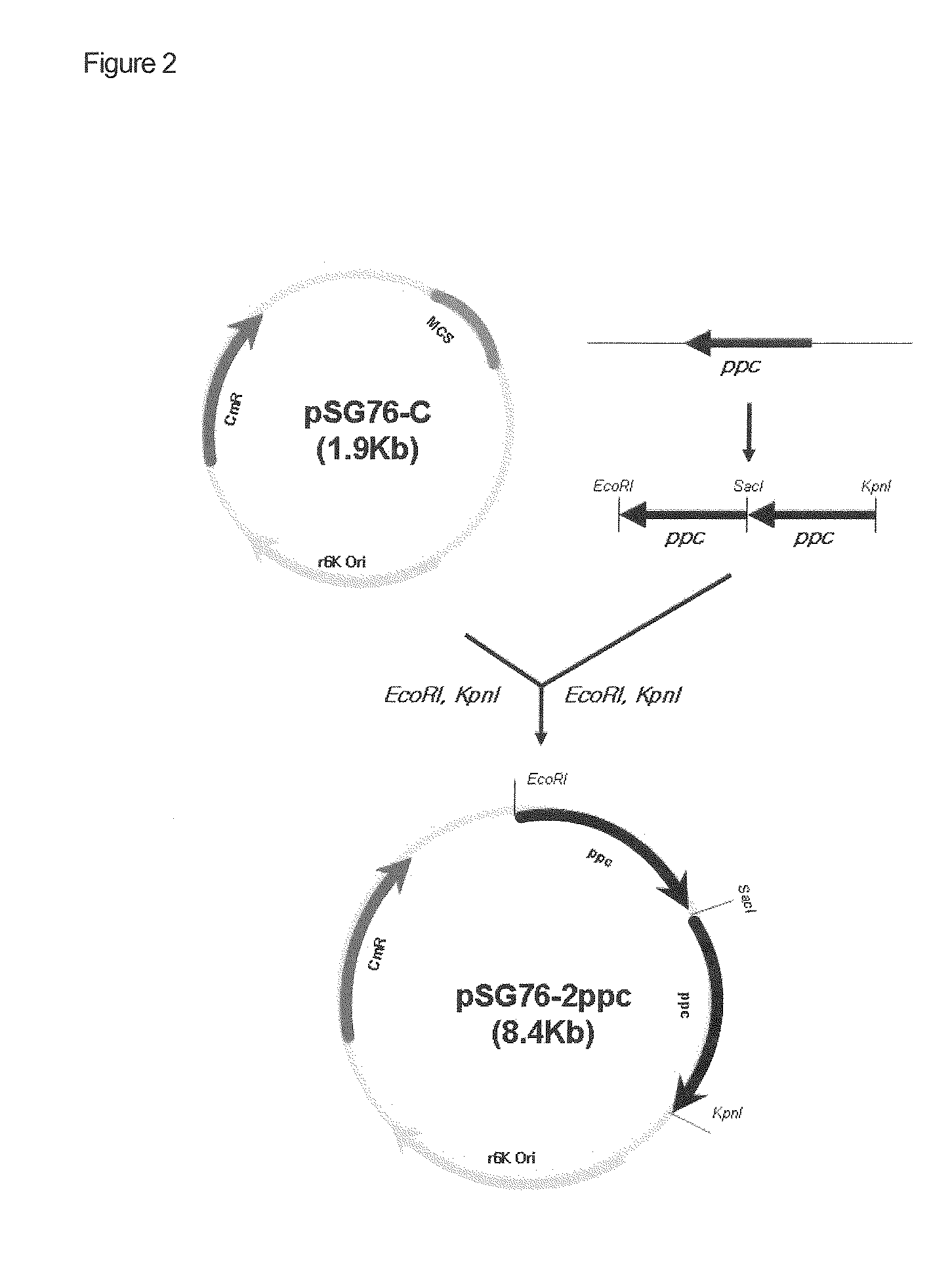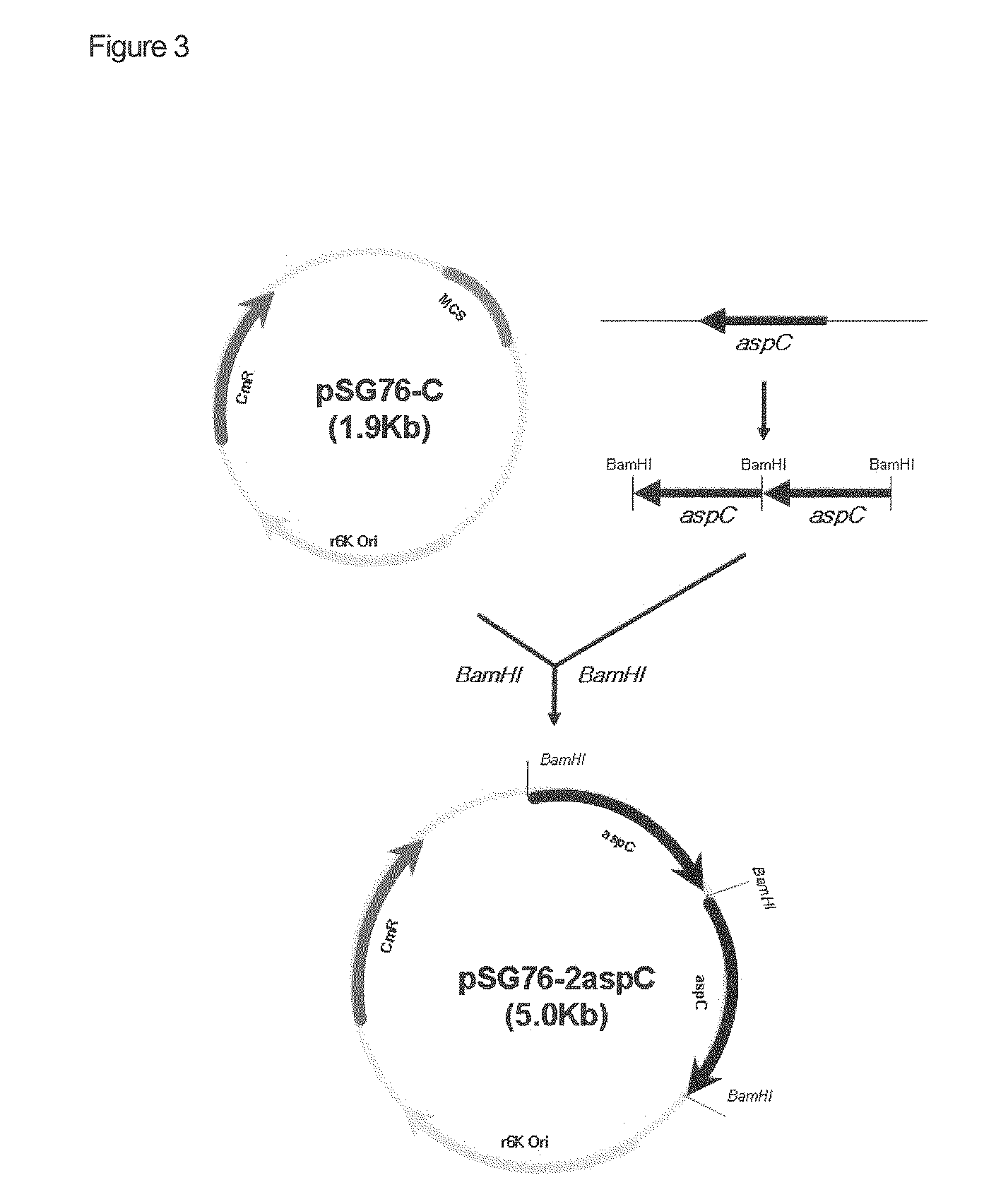Microorganism producing O-acetyl-homoserine and the method of producing O-acetyl-homoserine using the microorganism
a technology of oacetylhomoserine and microorganisms, which is applied in the field of microorganisms producing oacetylhomoserine and the method of producing oacetylhomoserine using the microorganisms, can solve the problems of disadvantageous methionine and difficult additional process, and achieve high yield and high yield
- Summary
- Abstract
- Description
- Claims
- Application Information
AI Technical Summary
Benefits of technology
Problems solved by technology
Method used
Image
Examples
example 1
Preparation of O-Acetyl Homoserine-Producing Strain
[0060] Construction of pSG Vector for Chromosomal Integration of ppc
[0061]For use in the integration of ppc into the chromosome of E. coli, a pSG-2ppc vector was constructed.
[0062]The base sequence of the ppc gene was obtained from the GenBank database of the NIH (NCBI-gi: 89110074). On the basis of this base sequence, two sets of primers for the amplification of the ppc gene were synthesized: one set starting from 200 bp upstream of the start codon of the ppc ORF and containing the restriction enzyme sites EcoRI and Sad (SEQ ID NOS. 1 and 2); and the other set starting from 200 bp upstream of the start codon of the ppc ORF and containing the restriction enzyme sites Sad and KpnI (SEQ ID NOS. 3 and 4).
[0063]While the chromosomal DNA of Escherichia coli W3110 served as a template, PCR was performed using a set of primers of SEQ ID NOS. 1 and 2 or SEQ ID NOS. 3 and 4 in the presence of high-fidelity DNA polymerase PfuUltra™ (Stratagen...
example 2
Fermentation for O-Acetyl Homoserine Production
[0087]In order to examine the strains prepared in Example 1 for ability to produce the methionine precursor O-acetyl homoserine, they were cultured in Erlenmeyer flasks.
[0088]For this culture, the O-acetyl-homoserine titer medium shown in Table 1 was employed.
[0089]
TABLE 1Composition of Medium for O-Acetyl-Homoserine ProductionCompositionConcentration(per liter)Glucose60gAmmonium Sulfate17gKH2PO41.0gMgSO4•7H2O0.5gFeSO4•7H2O5mgMnSO4•8H2O5mgZnSO45mgCaCO330gYeast Extract2gMethionine0.15gThreonine0.15g
[0090]Single colonies which were generated on LB plates during incubation overnight at 32° C. were taken with platinum loops and inoculated respectively into 25 mL of the O-acetyl homoserine titer medium, followed by culturing at 32° C. for 42˜64 hrs with shaking at 250 rpm. Each culture was quantitatively analyzed for O-acetyl homoserine using HPLC. The analysis data are summarized in Table 2, below.
[0091]Compared to the control CJM-X / pthrA(M...
PUM
| Property | Measurement | Unit |
|---|---|---|
| brittle | aaaaa | aaaaa |
| concentration | aaaaa | aaaaa |
| resistance | aaaaa | aaaaa |
Abstract
Description
Claims
Application Information
 Login to View More
Login to View More - R&D
- Intellectual Property
- Life Sciences
- Materials
- Tech Scout
- Unparalleled Data Quality
- Higher Quality Content
- 60% Fewer Hallucinations
Browse by: Latest US Patents, China's latest patents, Technical Efficacy Thesaurus, Application Domain, Technology Topic, Popular Technical Reports.
© 2025 PatSnap. All rights reserved.Legal|Privacy policy|Modern Slavery Act Transparency Statement|Sitemap|About US| Contact US: help@patsnap.com



